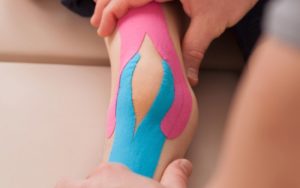Kinesio Taping
What Is Kinesio Taping?
Therapeutic tape is an elastic cotton tape with an acrylic adhesive. It is used to treat pain, inflammation, joint alignment issues and muscular inefficiencies. Kinesio taping method is a rehabilitative taping technique that is designed to facilitate the body’s natural healing process while providing support and stability to the muscles and joints.
Are There Different Kinds Of Taping Techniques? What Are They?
Kinesio Tape is elastic and flexible and meant to support the body while not inhibiting movement. There are different ways to apply the tape depending on the treatment goal. Different goals include: correcting joint alignment, inhibiting or facilitating muscles, and pain and inflammation reduction.
How Do You Prepare For A Therapeutic Tape?
In order to prepare for taping, the target area should be dry and free from lotion, oils etc. Next, the skin should be cleaned with an alcohol-based cleaner in order to facilitate the tapes adhesive ability. Body hair may also affect the adhesiveness of the tape and can also cause discomfort for some patients. If possible, shave the affected area before your taping session.
Why Is Taping Done?
Taping is performed for a few reasons and can be beneficial at any stage of injury (acute to chronic). It can be used to manage swelling immediately after injury or surgery, or to decrease pain as it lifts the skin to create more space directly above an area of pain or inflammation. It can also be used over tendons and ligaments to increase stimulation to injured tissue and can help to facilitate weak muscles or inhibit overactive and painful muscles. Lastly, taping can be used to facilitate proper joint position and posture.
What Can You Expect During Kinesio Taping?
 Before being taped, your therapist will clean your skin with an alcohol-based cleanser. Depending on the reason for taping, they may place your joints or muscles in certain positions for optimal results. Once the tape is in place, the therapist will rub it for one minute as the glue is activated by heat and friction. This will help the tape last longer. The tape is made to mimic the qualities of the superficial layer of skin so once it is on for a few minutes your body will be used to its presence.
Before being taped, your therapist will clean your skin with an alcohol-based cleanser. Depending on the reason for taping, they may place your joints or muscles in certain positions for optimal results. Once the tape is in place, the therapist will rub it for one minute as the glue is activated by heat and friction. This will help the tape last longer. The tape is made to mimic the qualities of the superficial layer of skin so once it is on for a few minutes your body will be used to its presence.
What Is The Follow Up To Taping?
Typically the tape lasts 3-5 days and you are able to shower and exercise with it on. The less exposure the tape has to water, the longer it will last, so we recommend showering only once per day. After you have the tape on for a few days, your therapist will follow up with you to see how it feels.
What Are The Potential Costs For Therapeutic Taping?
At Spring Forward taping is included in the treatment session for no extra charge. If you feel like your body benefited from the tape, some techniques can be taught in which you can buy your own roll and tape yourself. A roll usually costs around $15.00.
What Are The Potential Risks?
Taping should never be performed over an area of active malignancy, over fragile or healing skin, an area of infection, an open wound or over a deep vein thrombosis (DVT). Let your therapist know ahead of time if you are known to be allergic to medical tape or adhesive bandages. If you are taped and have an allergic reaction, later on, the tape can easily be removed from your skin. Taping also helps in aiding the movement of fluid so precaution should be taken with patients who have diabetes, kidney disease, asthma, congestive heart failure, and pregnancy.
Are There Other Related Treatments To Therapeutic Taping?
Taping will be used as part of your physical therapy plan of care in order to reduce pain and inflammation and also help facilitate the hands-on work your therapist has done with you.

